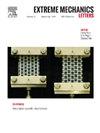负延展性超材料的被动隔振特性
IF 4.5
3区 工程技术
Q2 MATERIALS SCIENCE, MULTIDISCIPLINARY
引用次数: 0
摘要
负可扩展性指的是一类机械超材料,它们表现出一种不寻常的现象,即系统在张力下收缩。这类系统的动力学分析对于探索其隔振特性至关重要,是本研究的主要重点。受Braess悖论的启发,该力学模型结合了耦合可调的非线性弹簧刚度特性(应变硬化和软化),当超过一定的位移阈值时,它们会交替出现。这种刚度切换机构利用反弹跳不稳定性现象促进了宽频被动隔振。利用时域和频域图研究了由刚度切换机构产生的隔振特性。此外,利用三维参数空间可视化了刚度切换机构与系统各参数之间的关系。通过与现有双稳态系统的比较,对所提系统的有效性进行了评估,揭示了隔离高振幅振动的优越性能。提出的机制增强了对多稳定机械超材料关键结构元件动态行为的理解,为创新的自适应设计提供了见解和机会。本文章由计算机程序翻译,如有差异,请以英文原文为准。
Passive vibration isolation characteristics of negative extensibility metamaterials
Negative extensibility refers to the category of mechanical metamaterials that exhibit an unusual phenomenon where the system contracts upon tension. The dynamic analysis of such systems is crucial for exploring the vibration isolation characteristics, forming the prime focus of the present study. Inspired by Braess’s paradox, the mechanical model incorporates coupled tunable nonlinear spring stiffness properties (strain hardening and softening), which alternate when a certain displacement threshold is exceeded. This stiffness-switching mechanism facilitates wide-frequency passive vibration isolation using the phenomenon of counter-snapping instability. The vibration isolation characteristics resulting from the stiffness-switching mechanism are investigated using time- and frequency-domain plots. Furthermore, the relationship between the stiffness switching mechanism and various system parameters is visualized using a three-dimensional parametric space. The efficacy of the proposed system is evaluated by comparing it with the existing bi-stable systems, revealing superior performance in isolating high-amplitude vibrations. The proposed mechanism enhances the understanding of dynamic behaviors in critical structural elements for multi-stable mechanical metamaterials, providing insights and opportunities for innovative adaptive designs.
求助全文
通过发布文献求助,成功后即可免费获取论文全文。
去求助
来源期刊

Extreme Mechanics Letters
Engineering-Mechanics of Materials
CiteScore
9.20
自引率
4.30%
发文量
179
审稿时长
45 days
期刊介绍:
Extreme Mechanics Letters (EML) enables rapid communication of research that highlights the role of mechanics in multi-disciplinary areas across materials science, physics, chemistry, biology, medicine and engineering. Emphasis is on the impact, depth and originality of new concepts, methods and observations at the forefront of applied sciences.
 求助内容:
求助内容: 应助结果提醒方式:
应助结果提醒方式:


